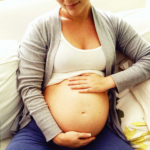While the use of lithium has been in decline over the last 20 years, lithium continues to be a useful and highly effective mood stabilizer for women with bipolar disorder, especially those with a history of mania. We have long been aware of its teratogenic effects, with some studies documenting an increased risk of cardiovascular malformations. Nonetheless the absolute risk of adverse events is relatively low, and lithium continues to be a viable treatment option during pregnancy for certain populations of women.
Risk of Cardiovascular Malformations: Data from the Medicaid Analytic Extract
In the 1970s, reports from the International Register of Lithium Babies suggested a very strong association between exposure to maternal lithium treatment during pregnancy and Ebstein’s anomaly, a right ventricular outflow tract obstruction defect of the heart. While it was initially estimated that Ebstein’s anomaly was about 400 times more common among children prenatally exposed to lithium than in unexposed children, these calculations were based on a registry of voluntarily submitted cases which most likely overestimated risk. More recent epidemiologic studies have consistently shown a much lower risk.
Most recently, Patorno and colleagues have estimated the risk of cardiac malformations in children exposed to lithium during the first trimester of pregnancy in a large retrospective cohort study of 1,325,563 pregnant women included in the U.S. Medicaid Analytic eXtract (MAX). In this study, exposure was defined as at least one filled prescription for lithium during the first trimester (first 90 days after the date of the last menstrual period). Two comparison groups were identified. The primary reference group included women with no lithium exposure. The researchers also compared outcomes to women with bipolar disorder who used lamotrigine as a mood stabilizer.
Overall Risk of Cardiovascular Malformations: The prevalence of cardiac malformations was 2.41 per 100 live births among lithium-exposed infants, 1.15 per 100 among unexposed infants, and 1.39 per 100 among lamotrigine-exposed infants. After controlling for potential confounding factors, the adjusted risk ratio for cardiac malformations in lithium-exposed infants was 1.65 (95% confidence interval [CI], 1.02 to 2.68) when compared to non-exposed infants.
The risk appears to be higher for right ventricular outflow tract obstruction defects – most likely Ebstein’s anomaly — than for other cardiac defects. Translating this into absolute risk, this means that if the risk of cardiovascular malformations is 1.15% in women with no exposure, the risk rises to about 1.9% in infants exposed to lithium. In this study, the risk of right ventricular outflow tract obstruction defects was 0.60 per 100 live births among infants exposed to lithium and 0.18 per 100 among unexposed infants.
Dose-Response Relationship: The researchers also looked at the impact of lithium dosage on risk for malformations and observed that risk increased as the dose of lithium increased. For a daily dose of 600 mg or less, the relative risk was 1.11 (95% CI, 0.46 to 2.64) and increased to 1.60 (95% CI, 0.67 to 3.80) for 601 to 900 mg. The association was statistically significant only in women receiving a lithium dose greater than 900 mg, with a relative risk of 3.22 for any malformation (95% CI, 1.47 to 7.02) for more than 900 mg.
Overall Risk of Malformations: Data from Meta-Analytic Studies
Meta-analyses have yielded similar data regarding the risk of malformations in infants exposed to lithium during the first trimester. In the most recent meta-analysis investigating the use of lithium during pregnancy, Fornaro and colleagues (2020) analyzed data from 13 studies. Lithium exposure during pregnancy was associated with higher odds of any congenital malformation (N=23,300; prevalence = 4.1%) with an odds ratio of 1.81 (95% CI=1.35–2.41) and a higher odds of any cardiac malformation (N=1,348,475; prevalence=1.2%) with an odds ratio of 1.86 (95% CI=1.16–2.96).
Risk of Adverse Pregnancy and Neonatal Outcomes
In a meta-analysis, Munk-Olsen and colleagues analyzed data from six study sites (Denmark, Canada, Netherlands, Sweden, UK, and US), analyzing outcomes in 727 lithium-exposed pregnancies and a reference group of 21,397 pregnancies in mothers with a mood disorder, but no exposure to lithium. Lithium exposure was not associated with pre-eclampsia, gestational diabetes, fetal distress, or postpartum haemorrhage. The two groups did not differ with regard to risk for caesarean section, preterm birth, low birthweight, or small for gestational age. The only observed difference was an increased risk for neonatal readmission to the hospital within 28 days of birth in lithium exposed (27·5%) versus non-exposed controls (14·3%) (Pooled aOR 1.62; 95% CI: 1.12–2.33).
Miscarriage: While two studies included in the Fornaro meta-analysis indicated that lithium exposure during the first trimester of pregnancy was associated with a increased risk of spontaneous abortion, the most recent meta-analysis concludes that this risk may be driven by the illness itself. When comparing pregnancy outcomes in women taking lithium to non-users with an affective illness, there is no difference between the two groups.
Preterm birth and low birth weight: In the Fornaro meta-analysis, lithium exposure during pregnancy was not associated with an increased risk of preterm birth when compared to any unexposed control group. Nor was lithium exposure associated with low birth weight.
Adverse Neonatal Outcomes: The literature includes reports of neonatal complications, including central nervous system and neuromuscular complications, longer duration of infant hospital stays, and lower Apgar scores. The overall prevalence of neonatal complications has not been established. In a report from Newport and colleagues, the risk of neonatal complications was higher in women with a median lithium serum level greater than 0.64 mEq/L. However, Molenaar et al (2021) observed no associations between neonatal lithium blood levels at the time of delivery and neonatal outcomes in a group of 29 infants.
Putting the Findings into a Clinical Context
Lithium exposure is associated with a small but statistically significant increased risk of cardiovascular malformations. According to a single study, the risk of cardiac malformations seemed to triple with dosages above 900 mg/day compared to dosages under 600 mg/day. While there is some risk associated with lithium exposure, this does not necessarily mean that women should discontinue or avoid treatment with lithium during pregnancy.
The data indicating lithium’s capacity to reduce risk for elapse is compelling. In the meta-analysis from Fornaro and colleagues, lithium was significantly more effective than no prophylaxis in preventing postpartum mood episodes (any polarity; follow-up range, 4 weeks to 2 years) in women with mood disorders (two studies, N=48; odds ratio=0.16, 95% CI=0.03–0.89). That is an 85% reduction in risk in a population at extremely high risk for postpartum illness.
As a rule, we try to avoid prescribing teratogens during pregnancy, but sometimes we simply cannot avoid this. Relapse rates in women with bipolar disorder are very high in women who discontinue mood stabilizers proximate to conception, and untreated bipolar illness in the mother carries risks, including risk of self-harm, alcohol and tobacco use, and poor compliance with prenatal care.
Some women may elect to stop treatment with lithium during pregnancy. With regard to alternatives, valproic acid (Depakote) is a significantly worse option, given its high teratogenic risk. Some women may be able to switch to lamotrigine (Lamictal), which has a good reproductive safety profile, although lamotrigine may not be as effective as lithium in protecting against manic symptoms. Atypical antipsychotic drugs are being used more commonly in this setting, although data on the reproductive safety of this class of medications is limited. But in many cases, lithium may remain the best option.
The finding of a dose-dependent association between lithium and cardiac malformations is interesting and may offer some possibilities for risk reduction. The risk is increased approximately threefold in doses above 900 mg per day. One might consider lowering the dose during the first trimester, although this approach may increase risk for relapse in some women. The other concern is that, since more than half of all pregnancies are unplanned, it may be difficult to adjust the dose of lithium after obtaining a positive pregnancy test and prior to the critical window of heart development (between 4 to 8 weeks after conception).
Overall the data regarding the use of lithium during pregnancy is reassuring. While several studies have shown that lithium carries some teratogenic risk, the current data indicates only a modest increase in the risk of cardiac malformations in infants with first trimester exposure to lithium. Women taking lithium for the treatment of bipolar disorder should review their treatment options with their treaters prior to pregnancy. In addition, we recommend that women treated with lithium during the first trimester should undergo fetal echocardiography and level-2 ultrasound to identify cardiovascular malformations.
Ruta Nonacs, MD PhD
Fornaro M, Maritan E, Ferranti R, Zaninotto L, Miola A, Anastasia A, Murru A, Solé E, Stubbs B, Carvalho AF, Serretti A, Vieta E, Fusar-Poli P, McGuire P, Young AH, Dazzan P, Vigod SN, Correll CU, Solmi M. Lithium Exposure During Pregnancy and the Postpartum Period: A Systematic Review and Meta-Analysis of Safety and Efficacy Outcomes. Am J Psychiatry. 2020 Jan 1; 177(1):76-92.
Molenaar NM, Poels EMP, Robakis T, Wesseloo R, Bergink V. Management of lithium dosing around delivery: An observational study. Bipolar Disord. 2021 Feb;23(1):49-54.
Munk-Olsen T, Liu X, Viktorin A, Brown HK, Di Florio A, D’Onofrio BM, Gomes T, Howard LM, Khalifeh H, Krohn H, Larsson H, Lichtenstein P, Taylor CL, Van Kamp I, Wesseloo R, Meltzer-Brody S, Vigod SN, Bergink V. Maternal and infant outcomes associated with lithium use in pregnancy: an international collaborative meta-analysis of six cohort studies. Lancet Psychiatry. 2018 Aug;5(8):644-652.
Newport DJ, Viguera AC, Beach AJ, Ritchie JC, Cohen LS, Stowe ZN. Lithium placental passage and obstetrical outcome: implications for clinical management during late pregnancy. Am J Psychiatry. 2005;162(11):2162?2170.
Patorno E, Huybrechts KF, Bateman BT, Cohen JM, Desai RJ, Mogun H, Cohen LS, Hernandez-Diaz S. Lithium Use in Pregnancy and the Risk of Cardiac Malformations. N Engl J Med. 2017 Jun 8; 376(23):2245-2254.








Leave A Comment